Diversity of chondritic organic matter probed by ultra-high resolution mass spectrometry
Affiliations | Corresponding Author | Cite as | Funding information- Share this article





-
Article views:323Cumulative count of HTML views and PDF downloads.
- Download Citation
- Rights & Permissions
top
Abstract
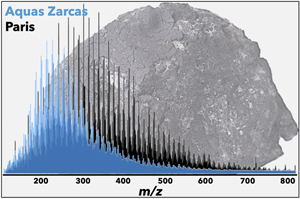
Figures
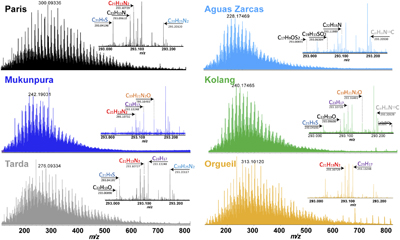 Figure 1 FTICR mass spectra obtained for CMs Paris, Aguas Zarcas and Mukundpura, as well as Tarda (C2) and Orgueil (CI). Zooms show the detected species in the range m/z = 293.0–293.2 (coloured formulae are used for commonly detected species). | 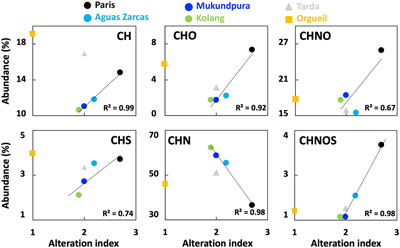 Figure 2 Molecular analysis derived from FTICR mass spectra as a function of respective alteration indexes for CM Paris, Aguas Zarcas and Mukundpura, as well as C2 Tarda and CI Orgueil. For each meteorite, the total attribution is reported in Table S-1. | 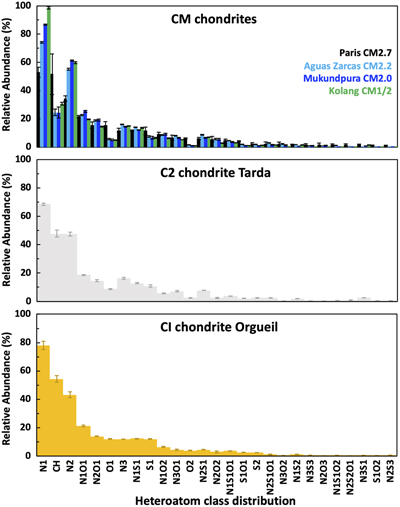 Figure 3 Relative abundances of the main heteroatom classes for CM Paris, Aguas Zarcas and Mukundpura (top), as well as C2 Tarda (middle) and CI Orgueil (bottom). Data are provided in Table S-2. | 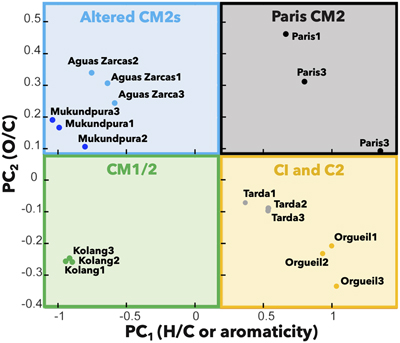 Figure 4 Principal components analysis of mass spectra of the CM, CI and C2 IOMs. Variability between meteorites results mainly from the aromaticity, or the H/C (at 84 %) and from the O/C (4 %), all determined from the mass spectra analysis. |
| Figure 1 | Figure 2 | Figure 3 | Figure 4 |
top
Introduction
The CM class of carbonaceous chondrites has been a preferred target for organic matter investigations (e.g., Sephton, 2002
Sephton, M.A. (2002) Organic compounds in carbonaceous meteorites. Natural Product Reports 19, 292–311. https://doi.org/10.1039/B103775G
). In CMs, most of the carbon resides in the form of insoluble macromolecules: insoluble organic matter (IOM). The IOM structure is constituted by small aromatic units connected by short and branched aliphatic chains, resulting in a high degree of cross-linking (Derenne and Robert, 2010Derenne, S., Robert, F. (2010) Model of molecular structure of the insoluble organic matter isolated from Murchison meteorite. Meteoritics & Planetary Science 45, 1461–1475. https://doi.org/10.1111/j.1945-5100.2010.01122.x
). Beside an unparalleled diversity, the IOM shows heterogeneity down to the micrometre scale, as revealed by the occurrence of D and 15N-rich hot spots (Busemann et al., 2006Busemann, H., Young, A.F., Alexander, C.M.O’D., Hoppe, P., Mukhopadhyay, S., Nittler, L.R. (2006) Interstellar Chemistry Recorded in Organic Matter from Primitive Meteorites. Science 312, 727–730. https://doi.org/10.1126/science.1123878
; Remusat et al., 2009Remusat, L., Robert, F., Meibom, A., Mostefaoui, S., Delpoux, O., Binet, L., Gourier, D., Derenne, S. (2009) Proto-planetary disk chemistry recorded by D-rich organic radicals in carbonaceous chondrites. The Astrophysical Journal 698, 2087. https://doi.org/10.1088/0004-637X/698/2/2087
). The molecular diversity and isotope heterogeneities could result from the accretion of organic particles having experienced different environments in the protosolar nebula (Remusat et al., 2009Remusat, L., Robert, F., Meibom, A., Mostefaoui, S., Delpoux, O., Binet, L., Gourier, D., Derenne, S. (2009) Proto-planetary disk chemistry recorded by D-rich organic radicals in carbonaceous chondrites. The Astrophysical Journal 698, 2087. https://doi.org/10.1088/0004-637X/698/2/2087
; Orthous-Daunay et al., 2013Orthous-Daunay, F.R., Quirico, E., Beck, P., Brissaud, O., Dartois, E., Pino, T., Schmitt, B. (2013) Mid-infrared study of the molecular structure variability of insoluble organic matter from primitive chondrites. Icarus 223, 534–543. https://doi.org/10.1016/j.icarus.2013.01.003
).As shown by the mineralogy, the CM parent body has experienced significant aqueous alteration (Rubin et al., 2007
Rubin, A.E., Trigo-Rodríguez, J.M., Huber, H., Wasson, J.T. (2007) Progressive aqueous alteration of CM carbonaceous chondrites. Geochimica et Cosmochimica Acta 71, 2361–2382. https://doi.org/10.1016/j.gca.2007.02.008
). Consequently, extended circulation of fluids may have blurred the imprint of the organic precursor. It then appears fundamental to assess the effects of the asteroidal evolution on the IOM. The comparative study of CMs exhibiting various degrees of alteration is decisive to establish or to rebut the possibility of a common organic precursor (Alexander et al., 2007Alexander, C.M.O’D., Fogel, M., Yabuta, H., Cody, G.D. (2007) The origin and evolution of chondrites recorded in the elemental and isotopic compositions of their macromolecular organic matter. Geochimica et Cosmochimica Acta 71, 4380–4403. https://doi.org/10.1016/j.gca.2007.06.052
), potentially preserved from the effects of the accretion processes.In the present study, we have applied laser desorption ionisation coupled with ultra-high resolution Fourier transform ion cyclotron resonance mass spectrometry (LDI-FTICR-MS). FTICR-MS offers unparalleled performances in term of mass resolution, mass accuracy and dynamic range (Marshall and Chen, 2015
Marshall, A.G., Chen, T. (2015) 40 years of Fourier transform ion cyclotron resonance mass spectrometry. International Journal of Mass Spectrometry 377, 410–420. https://doi.org/10.1016/j.ijms.2014.06.034
), optimal for the analysis of highly complex molecular mixtures. This technique has been recently proven successful at unravelling the molecular diversity of Paris IOM (Danger et al., 2020Danger, G., Ruf, A., Maillard, J., Hertzog, J., Vinogradoff, V., et al. (2020) Unprecedented Molecular Diversity Revealed in Meteoritic Insoluble Organic Matter: The Paris Meteorite’s Case. The Planetary Science Journal 1, 55. https://doi.org/10.3847/PSJ/abb60f
). To investigate the influence of the hydrothermal alteration on the molecular diversity of the IOM, our study extends to recent CM chondrite falls: Aguas Zarcas (CM2.2), Mukundpura (CM2.0) and down to Kolang (CM1/2), and compared to those previously acquired on Paris (CM2.7) (Danger et al., 2020Danger, G., Ruf, A., Maillard, J., Hertzog, J., Vinogradoff, V., et al. (2020) Unprecedented Molecular Diversity Revealed in Meteoritic Insoluble Organic Matter: The Paris Meteorite’s Case. The Planetary Science Journal 1, 55. https://doi.org/10.3847/PSJ/abb60f
). We have also investigated the IOM from Orgueil (CI1) and the ungrouped Tarda (C2), to evaluate if the molecular distributions are comparable in different asteroidal bodies.top
Methods
The IOM from each chondrite was isolated following an HF/HCl leaching procedure (see Supplementary Information). Recent falls range from Mukundpura (India, 2017), Aguas Zarcas (Costa Rica, 2019), Kolang (Indonesia, 2020) and Tarda (Morocco, 2021). The Aguas Zarcas sample was collected before the rain. To compare the attribution in chemical families, relative abundances are presented as a function of the alteration index. The alteration index was defined as 2.7 in Paris (Hewins et al., 2014
Hewins, R.H., Bourot-Denise, M., Zanda, B., Leroux, H., Barrat, J.-A., et al. (2014) The Paris meteorite, the least altered CM chondrite so far. Geochimica et Cosmochimica Acta 124, 190–222. https://doi.org/10.1016/j.gca.2013.09.014
), 2.2 in Aguas Zarcas (Martin and Lee, 2020Martin, P.M.C., Lee, M.R. (2020) Degree of Aqueous Alteration of the CM Carbonaceous Chondrite Aguas Zarcas: Implications for Understanding Ryugu and Bennu. 51st Lunar and Planetary Science Conference, Abstract #1375. https://www.hou.usra.edu/meetings/lpsc2020/pdf/1375.pdf
) and 2.0 in Mukundpura (Rudraswami et al., 2019Rudraswami, N.G., Naik, A.K., Tripathi, R.P., Bhandari, N., Karapurkar, S.G., Shyam Prasad, M., Babu, E.V.S.S.K., Vijaya Sarathi, U.V.R. (2019) Chemical, isotopic and amino acid composition of Mukundpura CM2.0 (CM1) chondrite: Evidence of parent body aqueous alteration. Geoscience Frontiers 10, 495–504. https://doi.org/10.1016/j.gsf.2018.02.001
). Kolang, described as CM1/2 (Gattaceca et al., 2021Gattacceca, J., McCubbin, F.M., Grossman, J., Bouvier, A., Bullock, E., et al. (2021) The Meteoritical Bulletin, No. 109. Meteoritics & Planetary Science 56, 1626–1630. https://doi.org/10.1111/maps.13714
), was assigned a 1.9 value. Tarda is classified as ungrouped C2 (Chennaoui Aoudjehane et al., 2021Chennaoui Aoudjehane, H., Agee, C.B., Ziegler, K., Garvie, L.A.J., Irving, A., et al. (2021) Tarda (C2-Ung): A New and Unusual Carbonaceous Chondrite Meteorite Fall from Morocco. 52nd Lunar and Planetary Science Conference, Abstract #1928. https://www.hou.usra.edu/meetings/lpsc2021/pdf/1928.pdf
), corresponding to 2.0 here, and Orgueil (CI1) to 1.0. LDI-FTICR-MS analyses were performed on a Bruker SolariX XR equipped with a 12T superconducting magnet. Laser ionisation parameters were tuned according to previous works (Maillard et al., 2018Maillard, J., Carrasco, N., Schmitz-Afonso, I., Gautier, T., Afonso, C. (2018) Comparison of soluble and insoluble organic matter in analogues of Titan’s aerosols. Earth and Planetary Science Letters 495, 185–191. https://doi.org/10.1016/j.epsl.2018.05.014
; Danger et al., 2020Danger, G., Ruf, A., Maillard, J., Hertzog, J., Vinogradoff, V., et al. (2020) Unprecedented Molecular Diversity Revealed in Meteoritic Insoluble Organic Matter: The Paris Meteorite’s Case. The Planetary Science Journal 1, 55. https://doi.org/10.3847/PSJ/abb60f
). Details of acquisition and molecular formula attributions parameters are reported in the Supplementary Information. Principal components analyses were performed on Matlab based script (details reported in Supplementary Information).top
Results
The high resolving power (2,160,000 at m/z = 200) allows the resolution of a large number of signals on each spectrum (Fig. 1). On average, 10,000 molecular formulae were assigned for each chondrite mass spectrum. The spectral spread or the position of the base peak (the most intense signal) are indicative of the molecular diversity. Altered CM2 Mukundpura, Aguas Zarcas and Kolang exhibit similar spectral shapes, with maximum intensities around m/z = 240 (Fig. 1). The Paris spectrum is the widest with the largest diversity of detected compounds, and it has distinctive patterns present at m/z > 400. With the narrowest mass spectrum, Kolang exhibits the lowest diversity. The Orgueil spectrum shows some similarities with Paris, while its maximum is around m/z = 310; the shape of the Tarda spectrum appears as intermediate between Paris and Orgueil. The total attribution of carbon groups derived from the mass spectra shows only a remote correlation with the extent of alteration. Detected species are lower for altered CM2 Mukundpura and CI Orgueil (below 5500), but maximal for Tarda (C2) and altered CM2.2 Aguas Zarcas (up to 8653, Table S-1).

Figure 1 FTICR mass spectra obtained for CMs Paris, Aguas Zarcas and Mukundpura, as well as Tarda (C2) and Orgueil (CI). Zooms show the detected species in the range m/z = 293.0–293.2 (coloured formulae are used for commonly detected species).
Here, CMs are aligned on the same trend, regardless of their functional chemistry (Fig. 2). The trend relates the abundance of chemical families and extent of the aqueous alteration, from weakly (Paris) to extensively altered (Kolang). This is indicative of a relationship between CMs, possibly sharing a common set of precursors. Orgueil sits outside that trend, so does Tarda, with the exception of the largest molecule CHNOS. The O-bearing groups are relatively more abundant in the least altered Paris (38 %), and less abundant (around 20 %) for all altered CMs. This is compatible with the loss of carbonyl groups during the experimental alteration of Paris IOM, resulting in an abundance comparable to Aguas Zarcas and Mukundpura (Laurent et al., 2022
Laurent, B., Holin, M., Bernard, S., Brunetto, R., Ciocco, M., Bouvier, C., Brunelle, A., Remusat, L. (2022) Evolution of Chondritic Insoluble Organic Matter Under Aqueous Alteration. 53rd Lunar and Planetary Science Conference, Abstract #1432. https://www.hou.usra.edu/meetings/lpsc2022/pdf/1432.pdf
). The CHN group is more abundant in altered CMs, with Kolang being the highest, despite showing the lowest diversity from its mass spectrum (Fig. 1). Although the nitrogen content has shown to slightly decrease with higher alteration in CM2s (Vinogradoff et al., 2017Vinogradoff, V., Le Guillou, C., Bernard, S., Binet, L., Cartigny, P., Brearley, A.J., Remusat, L. (2017) Paris vs. Murchison: Impact of hydrothermal alteration on organic matter in CM chondrites. Geochimica et Cosmochimica Acta 212, 234–252. https://doi.org/10.1016/j.gca.2017.06.009
), nitrogen in chondritic IOM is very stable, with only 15 % released from the IOM at 800 °C pyrolysis (Okumura and Mimura, 2011Okumura, F., Mimura, K. (2011) Gradual and stepwise pyrolyses of insoluble organic matter from the Murchison meteorite revealing chemical structure and isotopic distribution. Geochimica et Cosmochimica Acta 75, 7063–7080. https://doi.org/10.1016/j.gca.2011.09.015
). It is possible that only a small portion of nitrogen was ionised under the laser here.
Figure 2 Molecular analysis derived from FTICR mass spectra as a function of respective alteration indexes for CM Paris, Aguas Zarcas and Mukundpura, as well as C2 Tarda and CI Orgueil. For each meteorite, the total attribution is reported in Table S-1.
In terms of heteroatom classes, all IOMs are dominated by attributions with nitrogen containing groups (as N1 or N2) followed by light hydrocarbon CH and nitrogen oxide species, either N2O1 or N1O1 (Fig. 3). The difference between IOM resides here in the relative abundance of these heteroatom classes, the abundance of N1 for instance being higher in the more altered CM chondrites. Then, beside the various abundances and a seeming relationship with the alteration, the differences between IOM heteroatom classes are rather minute. To sort out such a large dataset where important variables are not readily apparent, exploratory statistical methods can be of use. A principal component analysis (PCA) is a non-supervised statistical analysis with the aim of reducing the dimensionality of a complex data set.

Figure 3 Relative abundances of the main heteroatom classes for CM Paris, Aguas Zarcas and Mukundpura (top), as well as C2 Tarda (middle) and CI Orgueil (bottom). Data are provided in Table S-2.
We performed the PCA analysis on all IOMs and four different regions were identified (Fig. 4). The four regions are separated by a PC1 component explaining >83 % of the differences and related to the saturation (H/C), while PC2 is related to the relative oxygen content. Altered CM2s are grouped together, with the most and least altered found to be located in their own quadrant. While being described as a CM1/2, Kolang occupies its own quadrant, with little similarities to Aguas Zarcas and Mukundpura. Tarda and Orgueil share the same quadrant, emphasising that Tarda differs from the CM2 subtype (Hewins et al., 2021
Hewins, R.H., Zanetta, P.M., Zanda, B., Le Guillou, C., Gattacceca, J., et al. (2021) NORTHWEST AFRICA (NWA) 12563 and ungrouped C2 chondrites: Alteration styles and relationships to asteroids. Geochimica et Cosmochimica Acta 311, 238–273. https://doi.org/10.1016/j.gca.2021.06.035
). By rastering the ionisation laser on the solid sample between each scan, FTICR should probe the sample’s spatial heterogeneity. In that respect, the most altered CM exhibits a remarkable homogeneity that may result from fluid circulation, as invoked in the homogenisation of the functional group content in Murchison and Orgueil (Le Guillou et al., 2014Le Guillou, C., Bernard, S., Brearley, A.J., Remusat, L. (2014) Evolution of organic matter in Orgueil, Murchison and Renazzo during parent body aqueous alteration: In situ investigations. Geochimica et Cosmochimica Acta 131, 368–392. https://doi.org/10.1016/j.gca.2013.11.020
). Conversely, it indicates that Paris IOM has preserved a certain chemical heterogeneity from the sources of IOM precursors.
Figure 4 Principal components analysis of mass spectra of the CM, CI and C2 IOMs. Variability between meteorites results mainly from the aromaticity, or the H/C (at 84 %) and from the O/C (4 %), all determined from the mass spectra analysis.
From the PCA analysis, molecular variability of each quadrant can be isolated and presented as a function of the number of π bonds and rings, namely the double-bond equivalent, DBE (Figs. S-2, S-3). In the case of ions containing only one nitrogen (CxHyN1) atom, Paris presents the largest diversity of aromatic species, with the largest number of species following the PAHs diagonal axis (Fig. S-3). Conversely, altered CMs have their N-rich species in the aliphatic region. Despite its pervasive alteration, Orgueil exhibits highly aromatic N-rich species and larger molecules than Paris.
top
Aqueous Alteration vs. Asteroidal Source; Influence on the Organic Matter Diversity
Linking carbonaceous chondrites to their parent asteroid remains a challenging task. In the case of a carbonaceous chondrite common organic precursor, Kolang should be related to Orgueil, both being highly altered. Our analysis point towards a common organic precursor for CM chondrites, proposed to originate from Ch and Cgh asteroids (see Vernazza et al., 2016
Vernazza, P., Marsset, M., Beck, P., Binzel, R.P., Birlan, M., Cloutis, E.A., DeMeo, F.E., Dumas, C., Hiroi, T. (2016) Compositional homogeneity of CM parent bodies. The Astronomical Journal 152, 54. https://doi.org/10.3847/0004-6256/152/3/54
). The diversity between CMs rather derives from the extent of asteroidal alteration, affecting both the composition (Fig. 2) and the heterogeneity (Fig. 3) of the analysed organic fraction. The presence of an additional precursor in some CMs was potentially revealed by FTICR as well. Aguas Zarcas is highly brecciated with a C1/2 lithology (Kerraouch et al., 2021Kerraouch, I., Bischoff, A., Zolensky, M.E., Pack, A., Patzek, M., et al. (2021) The polymict carbonaceous breccia Aguas Zarcas: A potential analog to samples being returned by the OSIRIS‐REx and Hayabusa2 missions. Meteoritics & Planetary Science 56, 277–310. https://doi.org/10.1111/maps.13620
) and departs from the CM trend for oxygen-bearing species CHO and CHNO, and in the case of CHS (Fig. 2). Tarda appears more as a CI-like type here, as attested by the similarities to Orgueil, in terms of mass spectrum shape (Fig. 1) and PCA analysis (Fig. 3). Tarda has been proposed to derive from D-type asteroids with higher ice proportion than C-type asteroids (Marrocchi et al., 2021Marrocchi, Y., Avice, G., Barrat, J.A. (2021) The Tarda Meteorite: A Window into the Formation of D-type Asteroids. The Astrophysical Journal Letters 913, L9. https://doi.org/10.3847/2041-8213/abfaa3
) while CIs have shown resemblance to the Cb-asteroid Ryugu samples recovered during the Hayabusa2 mission (Watanabe et al., 2017Watanabe, S.-I., Tsuda, Y., Yoshikawa, M., Tanaka, S., Saiki, T., Nakazawa, S. (2017) Hayabusa2 Mission Overview. Space Science Reviews 208, 3–16. https://doi.org/10.1007/s11214-017-0377-1
). In both cases, the parent bodies originate from distant regions, possibly outside the CO2 and H2O snowlines in the case of the Ryugu parent asteroid (Nakamura et al., 2022Nakamura, T., Matsumoto, M., Amano, K., Enokido, Y., Zolensky, M.E., et al. (2022) Early history of Ryugu’s parent asteroid: evidence from return sample. 53rd Lunar and Planetary Science Conference, Abstract #1753. https://www.hou.usra.edu/meetings/lpsc2022/pdf/1753.pdf
), whilst CI Orgueil possesses a volatile content of cometary origin (Gounelle and Zolenski, 2014Gounelle, M., Zolensky, M.E. (2014) The Orgueil meteorite: 150 years of history. Meteoritics & Planetary Science 49, 1769–1794. https://doi.org/10.1111/maps.12351
).Overall, FTICR-MS offers a new perspective on the study of the chondritic organic matter by allowing the simultaneous investigation of asteroidal alteration processes, as well as the remaining signature of the precursor sources. It may represent a prime tool to study samples from Hayabusa2 and OSIRIS-REx (Lauretta et al., 2017
Lauretta, D.S., Balram-Knutson, S.S., Beshore, E., Boynton, W.V., Drouet d'Aubigny, C., et al. (2017) OSIRIS-REx: Sample Return from Asteroid (101955) Bennu. Space Science Reviews 212, 925–984. https://doi.org/10.1007/s11214-017-0405-1
) missions, and the primitive organic molecules potentially preserved within asteroidal bodies.top
Acknowledgements
This work was supported by the European Research Council via the ERC project HYDROMA (grant agreement No. 819587).
Editor: Francis McCubbin
top
References
Alexander, C.M.O’D., Fogel, M., Yabuta, H., Cody, G.D. (2007) The origin and evolution of chondrites recorded in the elemental and isotopic compositions of their macromolecular organic matter. Geochimica et Cosmochimica Acta 71, 4380–4403. https://doi.org/10.1016/j.gca.2007.06.052
 Show in context
Show in context The comparative study of CMs exhibiting various degrees of alteration is decisive to establish or to rebut the possibility of a common organic precursor (Alexander et al., 2007), potentially preserved from the effects of the accretion processes.
View in article
Busemann, H., Young, A.F., Alexander, C.M.O’D., Hoppe, P., Mukhopadhyay, S., Nittler, L.R. (2006) Interstellar Chemistry Recorded in Organic Matter from Primitive Meteorites. Science 312, 727–730. https://doi.org/10.1126/science.1123878
 Show in context
Show in context Beside an unparalleled diversity, the IOM shows heterogeneity down to the micrometre scale, as revealed by the occurrence of D and 15N-rich hot spots (Busemann et al., 2006; Remusat et al., 2009).
View in article
Chennaoui Aoudjehane, H., Agee, C.B., Ziegler, K., Garvie, L.A.J., Irving, A., et al. (2021) Tarda (C2-Ung): A New and Unusual Carbonaceous Chondrite Meteorite Fall from Morocco. 52nd Lunar and Planetary Science Conference, Abstract #1928. https://www.hou.usra.edu/meetings/lpsc2021/pdf/1928.pdf.
 Show in context
Show in context Kolang, described as CM1/2 (Gattaceca et al., 2021), was assigned a 1.9 value. Tarda is classified as ungrouped C2 (Chennaoui Aoudjehane et al., 2021), corresponding to 2.0 here, and Orgueil (CI1) to 1.0.
View in article
Danger, G., Ruf, A., Maillard, J., Hertzog, J., Vinogradoff, V., et al. (2020) Unprecedented Molecular Diversity Revealed in Meteoritic Insoluble Organic Matter: The Paris Meteorite’s Case. The Planetary Science Journal 1, 55. https://doi.org/10.3847/PSJ/abb60f
 Show in context
Show in context This technique has been recently proven successful at unravelling the molecular diversity of Paris IOM (Danger et al., 2020).
View in article
To investigate the influence of the hydrothermal alteration on the molecular diversity of the IOM, our study extends to recent CM chondrite falls: Aguas Zarcas (CM2.2), Mukundpura (CM2.0) and down to Kolang (CM1/2), and compared to those previously acquired on Paris (CM2.7) (Danger et al., 2020).
View in article
Laser ionisation parameters were tuned according to previous works (Maillard et al., 2018; Danger et al., 2020).
View in article
Derenne, S., Robert, F. (2010) Model of molecular structure of the insoluble organic matter isolated from Murchison meteorite. Meteoritics & Planetary Science 45, 1461–1475. https://doi.org/10.1111/j.1945-5100.2010.01122.x
 Show in context
Show in context The IOM structure is constituted by small aromatic units connected by short and branched aliphatic chains, resulting in a high degree of cross-linking (Derenne and Robert, 2010).
View in article
Gattacceca, J., McCubbin, F.M., Grossman, J., Bouvier, A., Bullock, E., et al. (2021) The Meteoritical Bulletin, No. 109. Meteoritics & Planetary Science 56, 1626–1630. https://doi.org/10.1111/maps.13714
Gounelle, M., Zolensky, M.E. (2014) The Orgueil meteorite: 150 years of history. Meteoritics & Planetary Science 49, 1769–1794. https://doi.org/10.1111/maps.12351
 Show in context
Show in context In both cases, the parent bodies originate from distant regions, possibly outside the CO2 and H2O snowlines in the case of the Ryugu parent asteroid (Nakamura et al., 2022), whilst CI Orgueil possesses a volatile content of cometary origin (Gounelle and Zolenski, 2014).
View in article
Hewins, R.H., Bourot-Denise, M., Zanda, B., Leroux, H., Barrat, J.-A., et al. (2014) The Paris meteorite, the least altered CM chondrite so far. Geochimica et Cosmochimica Acta 124, 190–222. https://doi.org/10.1016/j.gca.2013.09.014
 Show in context
Show in context The alteration index was defined as 2.7 in Paris (Hewins et al., 2014), 2.2 in Aguas Zarcas (Martin and Lee, 2020) and 2.0 in Mukundpura (Rudraswami et al., 2019).
View in article
Hewins, R.H., Zanetta, P.M., Zanda, B., Le Guillou, C., Gattacceca, J., et al. (2021) NORTHWEST AFRICA (NWA) 12563 and ungrouped C2 chondrites: Alteration styles and relationships to asteroids. Geochimica et Cosmochimica Acta 311, 238–273. https://doi.org/10.1016/j.gca.2021.06.035
 Show in context
Show in context Tarda and Orgueil share the same quadrant, emphasising that Tarda differs from the CM2 subtype (Hewins et al., 2021).
View in article
Kerraouch, I., Bischoff, A., Zolensky, M.E., Pack, A., Patzek, M., et al. (2021) The polymict carbonaceous breccia Aguas Zarcas: A potential analog to samples being returned by the OSIRIS‐REx and Hayabusa2 missions. Meteoritics & Planetary Science 56, 277–310. https://doi.org/10.1111/maps.13620
 Show in context
Show in context Aguas Zarcas is highly brecciated with a C1/2 lithology (Kerraouch et al., 2021) and departs from the CM trend for oxygen-bearing species CHO and CHNO, and in the case of CHS (Fig. 2).
View in article
Laurent, B., Holin, M., Bernard, S., Brunetto, R., Ciocco, M., Bouvier, C., Brunelle, A., Remusat, L. (2022) Evolution of Chondritic Insoluble Organic Matter Under Aqueous Alteration. 53rd Lunar and Planetary Science Conference, Abstract #1432. https://www.hou.usra.edu/meetings/lpsc2022/pdf/1432.pdf.
 Show in context
Show in context This is compatible with the loss of carbonyl groups during the experimental alteration of Paris IOM, resulting in an abundance comparable to Aguas Zarcas and Mukundpura (Laurent et al., 2022).
View in article
Lauretta, D.S., Balram-Knutson, S.S., Beshore, E., Boynton, W.V., Drouet d'Aubigny, C., et al. (2017) OSIRIS-REx: Sample Return from Asteroid (101955) Bennu. Space Science Reviews 212, 925–984. https://doi.org/10.1007/s11214-017-0405-1
 Show in context
Show in context It may represent a prime tool to study samples from Hayabusa2 and OSIRIS-REx (Lauretta et al., 2017) missions, and the primitive organic molecules potentially preserved within asteroidal bodies.
View in article
Le Guillou, C., Bernard, S., Brearley, A.J., Remusat, L. (2014) Evolution of organic matter in Orgueil, Murchison and Renazzo during parent body aqueous alteration: In situ investigations. Geochimica et Cosmochimica Acta 131, 368–392. https://doi.org/10.1016/j.gca.2013.11.020
 Show in context
Show in context In that respect, the most altered CM exhibits a remarkable homogeneity that may result from fluid circulation, as invoked in the homogenisation of the functional group content in Murchison and Orgueil (Le Guillou et al., 2014).
View in article
Maillard, J., Carrasco, N., Schmitz-Afonso, I., Gautier, T., Afonso, C. (2018) Comparison of soluble and insoluble organic matter in analogues of Titan’s aerosols. Earth and Planetary Science Letters 495, 185–191. https://doi.org/10.1016/j.epsl.2018.05.014
 Show in context
Show in context Laser ionisation parameters were tuned according to previous works (Maillard et al., 2018; Danger et al., 2020).
View in article
Marshall, A.G., Chen, T. (2015) 40 years of Fourier transform ion cyclotron resonance mass spectrometry. International Journal of Mass Spectrometry 377, 410–420. https://doi.org/10.1016/j.ijms.2014.06.034
 Show in context
Show in context FTICR-MS offers unparalleled performances in term of mass resolution, mass accuracy and dynamic range (Marshall and Chen, 2015), optimal for the analysis of highly complex molecular mixtures.
View in article
Marrocchi, Y., Avice, G., Barrat, J.A. (2021) The Tarda Meteorite: A Window into the Formation of D-type Asteroids. The Astrophysical Journal Letters 913, L9. https://doi.org/10.3847/2041-8213/abfaa3
 Show in context
Show in context Tarda has been proposed to derive from D-type asteroids with higher ice proportion than C-type asteroids (Marrocchi et al., 2021) while CIs have shown resemblance to the Cb-asteroid Ryugu samples recovered during the Hayabusa2 mission (Watanabe et al., 2017).
View in article
Martin, P.M.C., Lee, M.R. (2020) Degree of Aqueous Alteration of the CM Carbonaceous Chondrite Aguas Zarcas: Implications for Understanding Ryugu and Bennu. 51st Lunar and Planetary Science Conference, Abstract #1375. https://www.hou.usra.edu/meetings/lpsc2020/pdf/1375.pdf.
 Show in context
Show in context The alteration index was defined as 2.7 in Paris (Hewins et al., 2014), 2.2 in Aguas Zarcas (Martin and Lee, 2020) and 2.0 in Mukundpura (Rudraswami et al., 2019).
View in article
Kolang, described as CM1/2 (Gattaceca et al., 2021), was assigned a 1.9 value. Tarda is classified as ungrouped C2 (Chennaoui Aoudjehane et al., 2021), corresponding to 2.0 here, and Orgueil (CI1) to 1.0.
View in article
Nakamura, T., Matsumoto, M., Amano, K., Enokido, Y., Zolensky, M.E., et al. (2022) Early history of Ryugu’s parent asteroid: evidence from return sample. 53rd Lunar and Planetary Science Conference, Abstract #1753. https://www.hou.usra.edu/meetings/lpsc2022/pdf/1753.pdf.
 Show in context
Show in context In both cases, the parent bodies originate from distant regions, possibly outside the CO2 and H2O snowlines in the case of the Ryugu parent asteroid (Nakamura et al., 2022), whilst CI Orgueil possesses a volatile content of cometary origin (Gounelle and Zolenski, 2014).
View in article
Okumura, F., Mimura, K. (2011) Gradual and stepwise pyrolyses of insoluble organic matter from the Murchison meteorite revealing chemical structure and isotopic distribution. Geochimica et Cosmochimica Acta 75, 7063–7080. https://doi.org/10.1016/j.gca.2011.09.015
 Show in context
Show in context Although the nitrogen content has shown to slightly decrease with higher alteration in CM2s (Vinogradoff et al., 2017), nitrogen in chondritic IOM is very stable, with only 15 % released from the IOM at 800 °C pyrolysis (Okumura and Mimura, 2011).
View in article
Orthous-Daunay, F.R., Quirico, E., Beck, P., Brissaud, O., Dartois, E., Pino, T., Schmitt, B. (2013) Mid-infrared study of the molecular structure variability of insoluble organic matter from primitive chondrites. Icarus 223, 534–543. https://doi.org/10.1016/j.icarus.2013.01.003
 Show in context
Show in context The molecular diversity and isotope heterogeneities could result from the accretion of organic particles having experienced different environments in the protosolar nebula (Remusat et al., 2009; Orthous-Daunay et al., 2013).
View in article
Remusat, L., Robert, F., Meibom, A., Mostefaoui, S., Delpoux, O., Binet, L., Gourier, D., Derenne, S. (2009) Proto-planetary disk chemistry recorded by D-rich organic radicals in carbonaceous chondrites. The Astrophysical Journal 698, 2087. https://doi.org/10.1088/0004-637X/698/2/2087
 Show in context
Show in context Beside an unparalleled diversity, the IOM shows heterogeneity down to the micrometre scale, as revealed by the occurrence of D and 15N-rich hot spots (Busemann et al., 2006; Remusat et al., 2009).
View in article
The molecular diversity and isotope heterogeneities could result from the accretion of organic particles having experienced different environments in the protosolar nebula (Remusat et al., 2009; Orthous-Daunay et al., 2013).
View in article
Rubin, A.E., Trigo-Rodríguez, J.M., Huber, H., Wasson, J.T. (2007) Progressive aqueous alteration of CM carbonaceous chondrites. Geochimica et Cosmochimica Acta 71, 2361–2382. https://doi.org/10.1016/j.gca.2007.02.008
 Show in context
Show in context As shown by the mineralogy, the CM parent body has experienced significant aqueous alteration (Rubin et al., 2007).
View in article
Rudraswami, N.G., Naik, A.K., Tripathi, R.P., Bhandari, N., Karapurkar, S.G., Shyam Prasad, M., Babu, E.V.S.S.K., Vijaya Sarathi, U.V.R. (2019) Chemical, isotopic and amino acid composition of Mukundpura CM2.0 (CM1) chondrite: Evidence of parent body aqueous alteration. Geoscience Frontiers 10, 495–504. https://doi.org/10.1016/j.gsf.2018.02.001
 Show in context
Show in context The alteration index was defined as 2.7 in Paris (Hewins et al., 2014), 2.2 in Aguas Zarcas (Martin and Lee, 2020) and 2.0 in Mukundpura (Rudraswami et al., 2019).
View in article
Sephton, M.A. (2002) Organic compounds in carbonaceous meteorites. Natural Product Reports 19, 292–311. https://doi.org/10.1039/B103775G
 Show in context
Show in context The CM class of carbonaceous chondrites has been a preferred target for organic matter investigations (e.g., Sephton, 2002).
View in article
Vernazza, P., Marsset, M., Beck, P., Binzel, R.P., Birlan, M., Cloutis, E.A., DeMeo, F.E., Dumas, C., Hiroi, T. (2016) Compositional homogeneity of CM parent bodies. The Astronomical Journal 152, 54. https://doi.org/10.3847/0004-6256/152/3/54
 Show in context
Show in context Our analysis point towards a common organic precursor for CM chondrites, proposed to originate from Ch and Cgh asteroids (see Vernazza et al., 2016).
View in article
Vinogradoff, V., Le Guillou, C., Bernard, S., Binet, L., Cartigny, P., Brearley, A.J., Remusat, L. (2017) Paris vs. Murchison: Impact of hydrothermal alteration on organic matter in CM chondrites. Geochimica et Cosmochimica Acta 212, 234–252. https://doi.org/10.1016/j.gca.2017.06.009
 Show in context
Show in context Although the nitrogen content has shown to slightly decrease with higher alteration in CM2s (Vinogradoff et al., 2017), nitrogen in chondritic IOM is very stable, with only 15 % released from the IOM at 800 °C pyrolysis (Okumura and Mimura, 2011).
View in article
Watanabe, S.-I., Tsuda, Y., Yoshikawa, M., Tanaka, S., Saiki, T., Nakazawa, S. (2017) Hayabusa2 Mission Overview. Space Science Reviews 208, 3–16. https://doi.org/10.1007/s11214-017-0377-1
 Show in context
Show in context Tarda has been proposed to derive from D-type asteroids with higher ice proportion than C-type asteroids (Marrocchi et al., 2021) while CIs have shown resemblance to the Cb-asteroid Ryugu samples recovered during the Hayabusa2 mission (Watanabe et al., 2017).
View in article
top
Supplementary Information
The Supplementary Information includes:
Download the Supplementary Information (PDF).
Figures
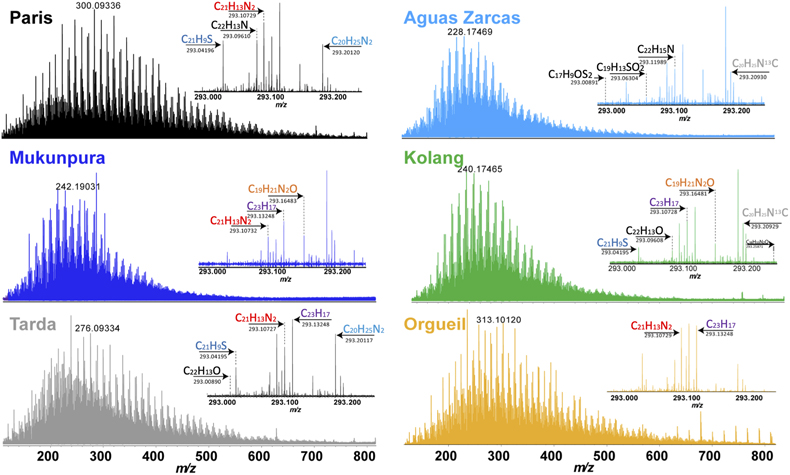
Figure 1 FTICR mass spectra obtained for CMs Paris, Aguas Zarcas and Mukundpura, as well as Tarda (C2) and Orgueil (CI). Zooms show the detected species in the range m/z = 293.0–293.2 (coloured formulae are used for commonly detected species).
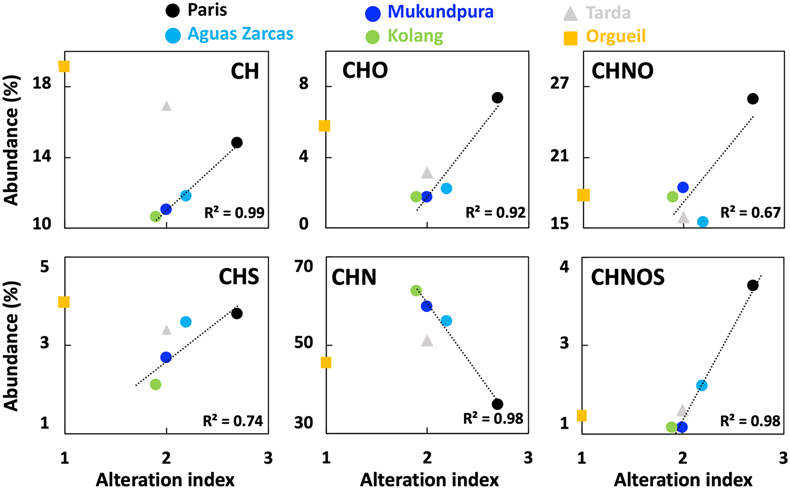
Figure 2 Molecular analysis derived from FTICR mass spectra as a function of respective alteration indexes for CM Paris, Aguas Zarcas and Mukundpura, as well as C2 Tarda and CI Orgueil. For each meteorite, the total attribution is reported in Table S-1.
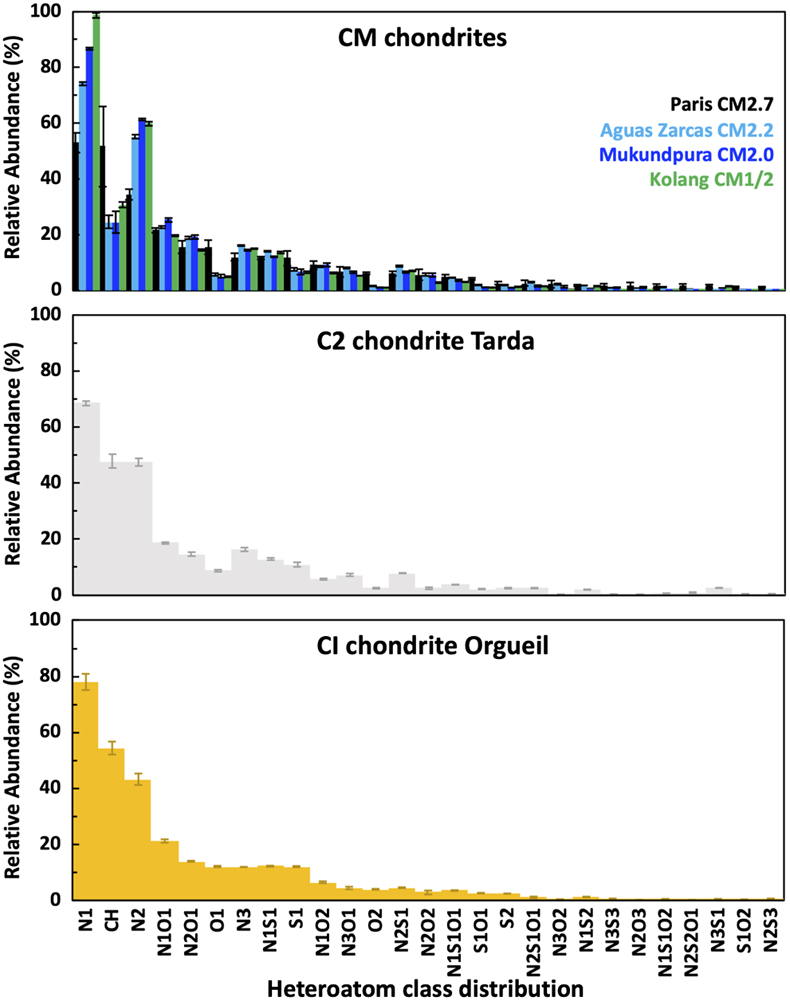
Figure 3 Relative abundances of the main heteroatom classes for CM Paris, Aguas Zarcas and Mukundpura (top), as well as C2 Tarda (middle) and CI Orgueil (bottom). Data are provided in Table S-2.
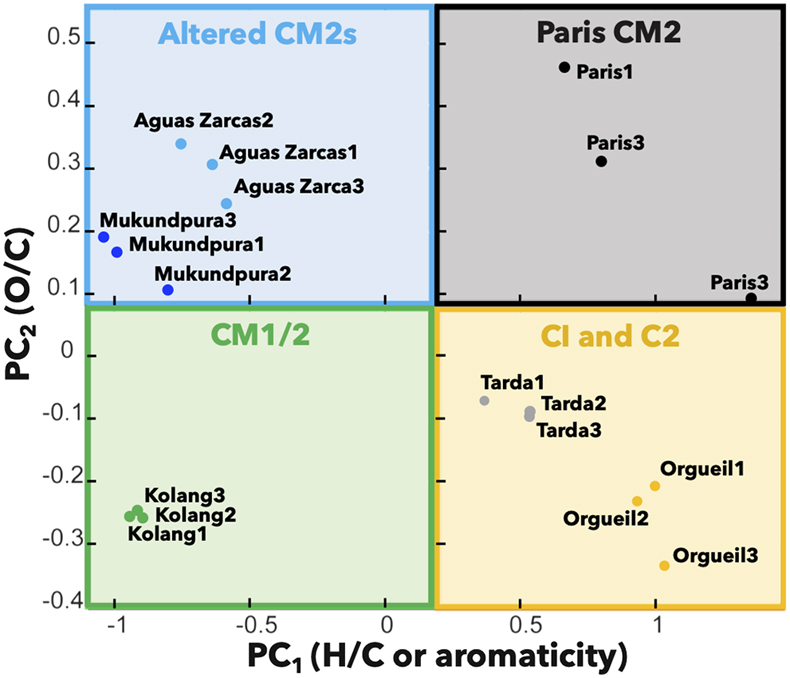
Figure 4 Principal components analysis of mass spectra of the CM, CI and C2 IOMs. Variability between meteorites results mainly from the aromaticity, or the H/C (at 84 %) and from the O/C (4 %), all determined from the mass spectra analysis.






